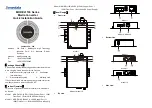
MODELS 5941D1, 5941SD1, 5942D1, & 5942SD1
INSTALLATION PROCEDURE
1. Model 5942 and Model 5942S ONLY
- Before connecting power, secure an earth ground wire to the ground stud
on the side of the unit. The ground stud has two nuts attached
.
The two nuts are used for attaching the ground wire.
Place the ground wire between these two nuts and securely tighten the nuts together.
2. Connect the Link to the communication port of the IED. Check the IED configuration to be sure of the correct
function and direction (signal flow) of each circuit. Typical connections are shown in the following table.
Î
Î
Î
Î
Note:
The Link does not use nor require the connection of these functions for its own operation.
Î
Î
Î
Î
Note:
The Signal Common pin (pin 5) of the Link is
shared
among all the channels.
LINK
Pin #
Function
Typical DCE
Connection
Handshaking
Typical DTE
Connection
Handshaking
IRIG-B
Connections
Contact Connections
1
Channel 1 Input
Transmitted Data (TD)
Transmitted Data (TD)
Transmitted Data (TD)
Transmitted Data (TD)
2
Channel 2 Input
Clear To Send (CTS)
Request To Send (RTS)
Sensed Contact
3
Channel 3 Input
Data Set Ready (DSR)
Data Terminal Ready
(DTR)
IRIG-B Clock Input
Sensed Contact
4
Channel 4 Input
Sensed Contact
5
Signal Common
Signal Common
Signal Common
Signal Common
Signal Common
6
Channel 1 Output
Received Data (RD)
Received Data (RD)
Received Data (RD)
Received Data (RD)
7
Channel 2 Output
Request To Send (RTS)
Clear To Send (CTS)
Driven Contact
8
Channel 3 Output
Data Terminal Ready
(DTR)
Data Set Ready (DSR)
IRIG-B Clock Output
Driven Contact
9
Channel 4 Output
Link Status Indicator*
Link Status Indicator*
Link Status Indicator*
Driven Contact or
Link Status Indicator*
* If Switch 1 Ch4 is set for Sync (Not Factory Default)
3. Connect the Fiber Optic Cable (FOC).
Î
Î
Î
Î
Note:
The FOC must connect a “T” optical port of one Link to the “R” optical port of the other Link. Both fibers must be
the same length. The use of duplex fiber is recommended.
4. Connect the power source to the Link.
•
Check the voltage rating next to the power connector - verify that it matches the power source
•
Remove the plug portion of the power connector by loosening the two captive mounting screws
•
Strip back 1/4" off the insulation of the wires that will connect the unit to the power source
•
Insert each conductor firmly into a terminal hole of the plug (note: this connection is not polarity sensitive)
•
Visually inspect that no strands of wire are straying out of the hole, potentially shorting to ground or to the other
conductor. Tighten the saddle screws until secure
•
Re-insert the plug into the power connector and secure the two captive mounting screws
5. Connect the power leads to the source. (The input is non-polarized). The unit is now powered.
6. Immediately upon both links being energized, the “POWER ON” and the “SYNC” LEDs will illuminate “steady”.
7. The Links and the optical circuit are now fully operational. The ”CH.1 T”, ”CH.2 T”, “CH 3 T” and the “CH.4 T” LEDs
will illuminate when the Link is transmitting optical signals. The “CH.1 R”, “CH.2 R”, “CH 3 R” and “CH. 4 R” LEDs
will illuminate when the Link is receiving optical signals.
WARNING
WHEN INSTALLING A MODEL 5942 OR 5942S LINK, AN EARTH GROUND (MINIMUM 14 GAUGE WIRE,
UPTO 5 FOOT LONG) MUST BE ATTACHED TO THE GROUND STUD ON THE SIDE OF THE CASE BEFORE
CONNECTING POWER. FAILURE TO FOLLOW THIS PROCEDURE MAY RESULT IN ELECTRICAL SHOCK
TO PERSONNEL.




















